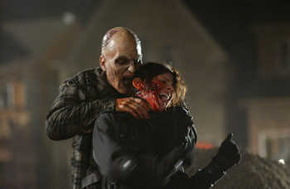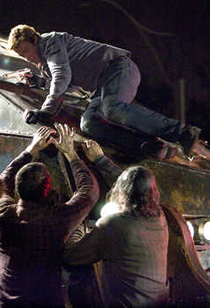Genre: Horror
Director: George A. Romero
Starring: Simon Baker, John Leguizamo, Dennis
Hopper, Asia Argento, Robert Joy
RunTime: -
Released By: UIP
Rating: M18
Release
Date: 11 August 2005
Synopsis
:
George
A. Romero’s Land of the Dead is the acclaimed director’s
long-awaited return to the horror genre he invented, beginning
with the seminal Night of the Living Dead and continuing with
Dawn of the Dead and Day of the Dead.
In
this new tale, Romero creates a harrowing vision of a modern-day
world where the walking dead roam an uninhabited wasteland
and the living try to lead “normal” lives behind
the walls of a fortified city. A new society has been built
by a handful of enterprising, ruthless opportunists, who live
in the towers of a skyscraper, high above the hard-scrabble
existence on the streets below. But outside the city walls,
an army of the dead is evolving. Inside, anarchy is on the
rise. With the very survival of the city at stake, a group
of hardened mercenaries is called into action to protect the
living from an army of the dead.
Movie
Review:
Director
George A. Romero should have been conferred the title of “The
Best Social-Message Zombie Director”. He has created
a cult following out of Night of the living Dead (1968), with
its theme of nuclear phobia that aligns itself well with films
like The China Syndrome (1979). He has swiftly followed up
with a sequel that is Dawn of the Dead (1978), this time focusing
on the adverse effects of consumerism, a by-product of capitalism.
Riding on the height of the success of its predecessor, the
film did relatively well in the box office. And Romero continued
his zombie tales with Day of the Living Dead (1985), this
time placing the limelight on conspiracy theory, a genre that
has found familiar ground with us in films like The Manchurian
Candidate (2004), Chinatown (1974), and The Parallax View
(1964).
And while
most of Romero’s fans expect his trilogy to be completed,
Romero surprised worldwide audience with his fourth installment
of the zombie film series Land of the Living Dead (2005),
this time revolving the plot around capitalism and globalisation.
And it is in due time, what with the domination of transnational
companies, the hybridisation of cultures and the pervasion
of globalisation. In Land of the Living Dead, Romero has created
a hierarchical structure of class categorisation: a hellish
place for the ostracised (read: zombies), a bearable albeit
run-down ghettos for its primary occupants and a utopia for
the capitalistic elite.
Within
the milieu of the film, the world is run by a capitalist Mr
Kaufman (Dennis Hopper), who dwells in his luxurious penthouse
known as Fiddler’s Green. Working under his wings is
Riley (Simon Baker), a noteworthy warrior who guards the periphery
of the city and burdened only by his humanity. Riley is accompanied
by Cholo (John Leguizamo), a hardened and trigger-happy patrol
trooper who will go all out to secure himself a place in Fiddler’s
Green. Together, both Riley and Cholo guard the city against
the zombies with the aid of “Dead Reckoning”,
a vehicle that proves to be a daunting war juggernaut.
With
electric, fortified fences and the water element, the status
quo is maintained between the ostracised zombie and its human
counterparts. However, the frequent raids and rampant killings
of the zombies by the humans soon enraged the zombies and
they retaliated by seeking to tread into unfamiliar territory:
Fiddler’s Green. Thereby begin the conflict that marks
the highlight of the film.
It’s
interesting that a substantial amount of scenes in the films
alludes to pro-globalisation and anti-capitalism. Riley apparently
opted for globalisation when he mentioned that he wanted a
“world without fences” and going against the killing
of the zombies. He also has a sidekick Charlie (Robert Joy),
who resembles a zombie. It seems that this character is deliberately
inserted by the director to suggest the inter-culture assimilation
of the zombie-human race. Through the use of weapons (machine-guns
for the trained humans versus knives welded by the zombies),
Romero has illustrated the unwanted effects of capitalism:
that the rich gets more powerful while the poor remains ignorant
and powerless.
The use
of euphemism such as “walkers” for zombies are
also used to good effect to portray terms often used by the
corporate elite to conceal certain bias or discrimination
that they may have (Think “re-structuring” for
retrenchment). Another good term that is employed is “Sky
Flowers” for fireworks, a tool that the humans used
as a distraction device for the zombies. However, the fact
that they are no longer distracted by the fireworks towards
the end of the film signifies that ultimately, all of us wakes
up from the lure of materialism as well as consumerism and
recognise that these are merely the camouflage devices of
capitalism.
The film is not without its blemishes though. Sporadically
and strategically placed are numerous dialogues dosed with
dark humour. This may sit well with some while creating discomfort
for the rest in these times of instability. Certain characters
in the film (such as Kaufman) are also simply caricatures
with no room for character development.
Nevertheless,
this is one memorable film.
In
the midst of a hardcore gore-fest lies a film with a great
and memorable social message. Deciphering it is not difficult
and once that is achieved, the audience will be able to appreciate
what a remarkable director Romero is. And has always been.
Movie
Rating:
  
("A film of wide appeal, with a unique concoction that
blends an underlying thematic message with the surface action!")
Review
by Patrick Tay
|




